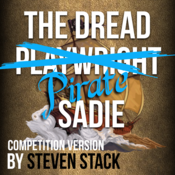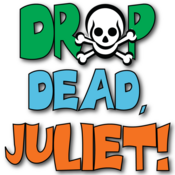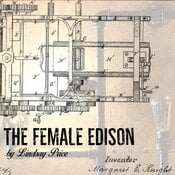🐔 Why did the chicken cross the road? To spark powerful conversations! The new competition version of Chicken. Road. is a compelling, issue-based play that creates space for meaningful discussions. A perfect choice for your next one-act festival. Click to learn more!
Play Scripts for Schools for Competitions
The Dread Pirate Sadie: Competition Version
A competition-length adaptation of The Dread Pirate Sadie by Steven Stack
- About 35 minutes
- 1 M + 10 F + 1 Any Gender
- Simple set
- Recommended for High Schools & Middle Schools
- 35 pages
Drop Dead, Juliet!
Juliet has had enough! No more poison, stabbing, or dying. Romeo and Juliet will never be the same - or will it? Not everyone's so keen on the changes.
- About 30 minutes
- 4 M + 13 F + 1 Any Gender
- Simple Set
- Recommended for High Schools & Middle Schools
- 30 pages
ellenalicemonajune
Ellen, Alice, Mona, and June share those uncomfortable truths that only close friends can tell each other.
- About 25 minutes
- 4 F
- Simple Set
- Recommended for High Schools
Emotional Baggage
Seven strangers meet in a train station. Instead of luggage, they all carry their "emotional baggage." The most unique play we sell - it has no dialogue.
- About 30 minutes
- 4 M + 4 F
- Simple Set
- Recommended for High Schools & Middle Schools
- 27 pages
Epic Adventures in a Rinky-Dink Art Museum
A character driven comedy about art, romance, and mystery. This rinky-dink art museum holds more interest than what first meets the eye.
- About 35 minutes
- 5 M + 7 F
- Simple Set
- Recommended for High Schools & Middle Schools
- 40 pages
The Exile and the Onion Girl
A vividly modern adaptation of Aeschylus' play The Libation Bearers.
- About 35 minutes
- 4 M + 6 F, Plus Domestics (chorus)
- Simple set
- Recommended for High Schools
- 33 pages
The Factory
Robots will always do their jobs better than real people. And rules are what make the Factory productive.
- About 30 minutes
- 16 Any Gender
- Simple set
- Recommended for High Schools & Middle Schools
- 30 pages
Failure and Fortitude: The Female Edison
Failure and fortitude are the touchstones for every inventor, but even more so for 19th century female inventors.
- About 40 minutes
- 1 F + 12 Any Gender, plus 3 groups (3/4/4)
- Simple set
- Recommended for High Schools & Middle Schools
- 49 pages
The Female Edison
Margaret E. Knight was a 19th century inventor with two big but forgotten stories.
- About 70 minutes
- 2 F + 22 Any Gender
- Simple set
- Recommended for High Schools & Middle Schools
- 79 pages
Fidget
Kids are constantly being told to hold still. But that’s impossible when all they want to do is move forward at warp speed.
- About 30 minutes
- 6 Any Gender, Expandable to 28
- Simple set
- Recommended for High Schools & Middle Schools
- 27 pages
Finding Jo March
You should know right away that this is not a traditional adaptation of Little Women.
- About 120 minutes
- 5 M + 5 F + 1 Any Gender + 3 F or NB
- Recommended for High Schools
- 85 pages
Finishing Sentences
A play that forces us to consider the human side of the people we often dismiss.
- About 35 minutes
- 4 M + 6 F + 8 Any Gender, Easily expandable
- Simple set
- Recommended for High Schools & Middle Schools
- 44 pages
Flaky Lips
Two girls live in two communities that have been separated by a wall for a hundred years.
- About 45 minutes
- 2 F
- Simple Set
- Recommended for High Schools
- 30 pages
flawless leArnIngs
In a data-driven future, an AI teacher's chilling efficiency sparks a fight for authenticity and self-expression.
- About 25 minutes
- 6 Any Gender, plus optional additional students
- Simple set
- Recommended for High Schools
- 20 pages
Floating on a Don't Care Cloud
An emotional tug of war between a sister and brother and what really happens in the world of teenage marijuana use. A vivid personification of drugs.
- About 40 minutes
- 3 M + 5 F + 7 Any Gender
- Simple Set
- Recommended for High Schools
- 42 pages
Football Romeo
A hilarious full length modern take on the clash between school cliques. Inspired by Romeo and Juliet.
- About 75 minutes
- 3 M + 7 F
- Simple Set
- Recommended for High Schools & Middle Schools
- 76 pages
Football Romeo (Ten Minute Version)
A football player tries to tackle Shakespeare.
- About 10 minutes
- 2 M + 2 F
- Simple Set
- Recommended for High Schools
Franz Kafka Cancels His Cell Phone Plan
A modern absurdist play that puts elements from three of Franz Kafka’s works into the context of the everyday absurdities of our 21st century lives.
- About 25 minutes
- 5 Any Gender
- Simple set
- Recommended for High Schools & Middle Schools
- 17 pages
Free - Version 1
A free picnic forces a struggling town to reconcile their belief systems with their greed.
- About 45 minutes
- 6 M + 10 F + 3 Any Gender
- Simple Set
- Recommended for High Schools
- 40 pages
Free - Version 2
A free picnic forces a struggling town to reconcile their belief systems with their greed. More parts for girls in Version 2.
- About 45 minutes
- 4 M + 12 F + 2 Any Gender
- Simple Set
- Recommended for High Schools
- 40 pages



















